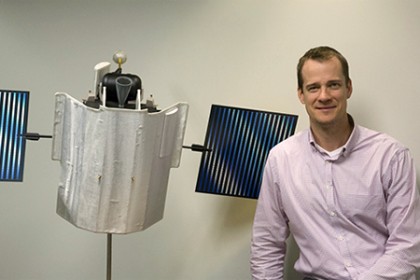Daniel O'Shaughnessy, an engineer at the Johns Hopkins University Applied Physics Laboratory, has been named the first recipient of the Heinlein Award for his development of a spacecraft navigational technique that makes use of solar radiation pressure.

Image caption: Daniel O'Shaughnessy
The Robert A. and Virginia Heinlein Prize Trust, a nonprofit foundation promoting the commercial uses of space, created the Heinlein Award to recognize space-tested technologies that can benefit commercial space activities. O'Shaughnessy will be recognized at a dinner at the Air and Space Museum in Washington, D.C., on Nov. 21.
O'Shaughnessy employed the award-winning technique—known as solar sailing—while working as guidance and control lead engineer for the Messenger mission. The team relied on six planetary gravity assists to enable a Mercury orbit, but solar radiation pressure was considered a threat to the success of these maneuvers.
Ultimately, the team found a way to use the solar radiation pressure to its advantage by using the light pressure on its solar panels to perform fine trajectory corrections on the way to Mercury. By changing the angle of the solar panels relative to the sun, the amount of pressure was varied to adjust the spacecraft trajectory more delicately than possible with thrusters. Minor errors are greatly amplified by gravity assist maneuvers, so using radiation pressure to make very small corrections saved propellant and helped to extend the life of the mission.
"This work exemplifies the teamwork that has made the Messenger mission a success," said Mike Ryschkewitsch, head of APL's Space Exploration Sector. "Modifying the trajectory via solar sailing instead of thruster burns required tight coupling of mission designers, navigators, guidance and control engineers, and the spacecraft operations team. Active participation from each of these team members was essential to achieving the paradigm shift."
Added O'Shaughnessy: "While most commercial endeavors are not planning interplanetary trajectories, the demonstration of this capability has applications closer to home. Many earth-orbiting missions require precision orbit control and could potentially use this technique to provide very accurate orbit maintenance without requiring expensive onboard propellants."
The award is named for Robert A. Heinlein, an influential American science fiction writer, and Virginia Heinlein, his wife of nearly 40 years. Heinlein published more than 150 novels, short stories, and articles united by an underlying theme of the the practical benefit of man's activities in space. Heinlein wrote in the face of prevailing opinions of the time that declared such endeavors to be impractical and impossible.
Posted in Science+Technology








